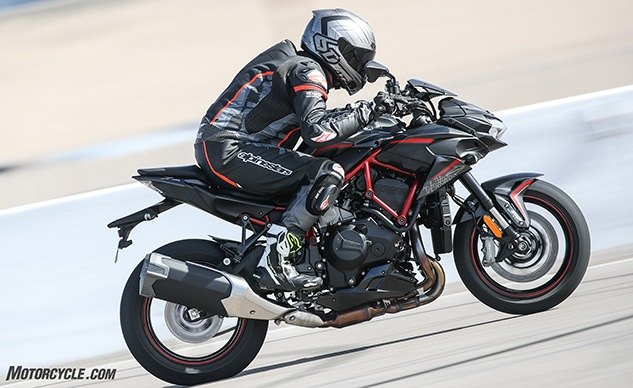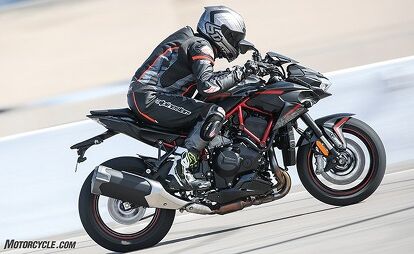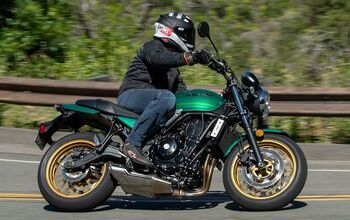2020 Kawasaki Z H2 Review - First Ride

A naked rocket ship
When one thinks about Las Vegas, thoughts naturally tend towards gambling, bright lights, overpriced restaurants (or buffet food), and desert heat – not standing beside the road course at Las Vegas Motor Speedway with the temperature on the wrong side of 40° while a 200-hp beast idles its way to operating temperature. This is the type of scenario where having track rubber with tire warmers would be significantly less desirable than the Pirelli Diablo Rosso III street tires the 2020 Kawasaki Z H2 I was about to mount was sporting. The first lap would suck the heat out of those toasty warm sticky track compounds rendering them useless. Street tires, however, have a much broader operational temperature envelope.
2020 Kawasaki Z H2
| Engine | 19.0/20 |
| Suspension/Handling | 13.0/15 |
| Transmission/Clutch | 8.75/10 |
| Brakes | 9.0/10 |
| Instruments/Controls | 4.5/5 |
| Ergonomics/Comfort | 9.0/10 |
| Appearance/Quality | 9.0/10 |
| Desirability | 9.25/10 |
| Value | 8.75/10 |
| Overall Score | 90.25/100 |
2015 Kawasaki Ninja H2 First Ride Review
2018 Kawasaki H2 SX SE First Ride Review
So, we tiptoed out onto the track to follow a Kawasaki rider for a lap or two while we tried to learn the layout of the course and warm our tires before we were set loose. A couple of laps into the first session, I entered a dual-apex left-hander, clipped the first apex, drifted wide, and then dialed in more lean to come back for the second apex. At this moment, the handlebar folded towards the steering lock…
More than just an inline-Four
A modern 998 cc DOHC four-valve per cylinder inline-Four is nothing to sneeze at, but what makes the Z H2’s engine special – and helps it crank out a claimed 197 hp – resides on the back of the engine just above the transmission. The special sauce is a 69mm planetary gear driven supercharger impeller that is massaged out of a single chunk of forged aluminum with the assistance of five-axis CNC machining. This process creates an extremely efficient blade shape, with 6 blades at its tip and 12 blades at its base, negating the need for the space and weight of an intercooler. Instead, the aluminum intake chamber between supercharger and throttle bodies helps to manage the heat generated through compression. Additionally, the intake chamber has been volume-optimized to enhance the supercharger’s efficiency. Then the irregular-length intake funnels contribute to the engine’s bottom end and mid-range performance – a necessary rpm range for a naked bike. A sizable ram air intake on the left side of the headlight feeds the supercharger with cool air to compress.
For intake efficiency, the Z H2 borrows from the World Superbike spec ZX-10R in the form of the two-step cylinder head machining to smooth intake flow and minimize any intake loss. Since the Z H2 is a street-focused motorcycle, the cam profiles are directed towards real-world power delivery and fuel economy. The 11.2:1 compression ratio contributes to fuel efficiency and thermal management, allowing the use of a single oil jet to cool the backside of each piston. This, in turn, allows the oil pump to spin at a lower speed for less parasitic power loss, while the deep sump makes sure that the oil gets to where it needs to be, even under hard acceleration.
Kawasaki says it turned to MotoGP technology (though we don’t know whose) for the transmission with the inclusion of a dog-ring transmission setup which utilizes fixed gears on the input shaft and rings that engage the output shaft’s gears by moving between them. Kawasaki claims this results in improved feel with lighter, quicker shifts. To that transmission, Kawasaki adds an assist and slipper clutch for easy clutch manipulation in traffic and prevention of rear wheel hop in the case of ham-fisted downshifts.
The electronics suite
Feeding the supercharged beast are a quartet of 40mm throttle bodies that utilize ECU-controlled Electronic Throttle Valves. This ride-by-wire control allows for smooth power delivery as well as electronic features like cruise control, Kawasaki Quick Shifter, Kawasaki Launch Control, and Kawasaki Engine Brake Control – all the stuff a modern hypernaked bike needs.
The basis for the Z H2’s electronic rider aids is a 5-axis Bosch IMU which reads the following axes: acceleration along longitudinal, transverse and vertical axes, roll rate, and pitch rate. A sixth axis, yaw rate, is calculated by the ECU. Using all that information, the Z H2 has Kawasaki Corner Management Function to help the rider maintain their desired line through a corner by managing the tendency to stand up under braking by leveraging the Kawasaki Intelligent Anti-Lock Brake System and Kawasaki Traction Control. Kawasaki Launch Control Mode modulates wheelspin and front wheel lift when accelerating from a stop. Then there are the four ride modes (Sport, Road, Rain, and Rider (custom)) which control the traction control and power delivery.
The instrumentation also features Bluetooth connectivity allowing the rider to use Kawasaki’s Rideology app. This allows the rider to check the status of the motorcycle remotely and change the instrument display and riding modes via a smartphone. However, the killer feature of the app is the Ride Log, which utilizes the phone’s GPS to capture the ride’s route and important details like top speed. The Z H2 provides fun facts like maximum lean angle. As a rider who does track days, I love the idea of being able to compare sessions and look for improvements in speed and lean.
A naked chassis
While the Z H2’s trellis frame may look similar to that of its siblings in the H2 family, it is a ground-up design that is tuned with the goal of providing optimal performance at highway speed and emphasizing low-speed maneuverability. Constructed of high-tensile steel, the frame’s tubing diameter and bend were specifically chosen for the desired compromise between stiffness and flexibility that suits a street-focused bike. Handling and high-speed stability are enhanced by the lowered center-of-gravity enabled by the forward tilt of the engine. For a large motorcycle, Kawasaki took pains in making sure that the Z H2 still has as narrow a waist as possible to ease the rider’s reach to the ground.
In a first for the H2 line, a double-sided cast aluminum swingarm similar to those used on Kawasaki’s Ninja supersports is used on the Z H2. This setup gives the right combination of stiffness and light weight. For a similar reason, the swingarm mounting plate bolts directly to the engine, which acts as a frame cross member for stiffness with minimal weight.
Connecting the frame to the front wheel is a Showa SFF-BP (Separate Function Fork – Big Piston) fork. Although both legs have springs, preload adjustment is made on the left leg. Compression and rebound settings are handled on the right leg. The Uni-Trak rear suspension uses a fully-adjustable Showa shock.
A surprise with the brakes
For premium performance motorcycles, we’ve gotten pretty used to seeing Brembo M50s or, more recently, Stylemas mounted to the bottom of fork legs. Imagine my surprise when I saw the radial mount four-piston M4.32 calipers on the Z H2. Not that they are bad calipers at all. Additionally, Kawasaki chose to pair the Brembo calipers with a Nissin master cylinder for this project, and after a day in the saddle, they do a great job of scrubbing off speed via a pair of 320mm discs. My guess is that the calipers, like the choice to eschew braided steel brake lines, was a cost saving measure. A two-piston caliper scrubs a 250mm rear disc.
Back in the saddle
When last we met, our narrator was in the middle of a corner with the handlebar doing what you never want it to do mid-corner. Just moments later, I’m happy to say that the front Pirelli Diablo Rosso III gathered itself back up, sending me on my way just ahead of the adrenaline rush. My role in the recovery was entirely that of not making a bad situation worse. This and one more waggle of the handlebar in the first session made sure that I treated the 527 lb. (claimed), 197-hp bike with kid gloves for the remainder of the chilly road course sessions.
Still, a remarkable amount can be learned when riding at what is closer to a street cornering pace than a track one. First, Kawasaki made a big deal about saying the Z H2 has balanced power, and when you’re encountering slips front and rear, tractable power is paramount. For a bike capable of such impressive acceleration, the ease of the throttle control, particularly in the lower rpm, belies the brute force that the engine can put out when you want it to. Exiting corners in Road mode allows a little rear slip as the bike straightens up and rockets down the straight. The quickshifter snicks through the gears as the front end gets light, and before you know it, the brake markers are rapidly approaching. The Nissin/Brembo combo hauls the 700 lb. of bike and rider down from speed with excellent power and feel.
The high point of Kawasaki’s plans for the Z H2 introduction was the trip to the Las Vegas Motor Speedway’s 20° banked tri-oval. The exercise was designed to allow journalists to experience both the brutal acceleration from the bottom end and high speed acceleration coming out of the banked corners. Each lap was punctuated by a trip into the infield chicane to give us the chance to brake down from speeds approaching 150 mph.
Accelerating up onto the banking from second gear with the throttle wide open, the rider is pushed back into the seat as the front end lightens. People who were more aggressive on the throttle than I lofted the front wheel to the limits of the wheelie control. It’s freaky accelerating into a heavily banked turn because you can carry so much more speed than you think you can. Regardless, each lap as I exited the western corner of the track, I tried to get on the throttle earlier and was rewarded with progressively higher speeds at the end of the straight before rolling out of the throttle for the next corner. The acceleration was mind bending as the corner came up to greet me. In the end, I saw 158 mph indicated as my top speed. Lighter, more flexible riders, who could tuck more efficiently than me, saw even higher speeds. After the second banked turn and a slightly shorter straight, it was time to grab a handful of brake and tap down through the gears to second for the chicane. This deceleration was almost as fun as running up through the gears and highlights how effective the Z H2’s brakes are.
My only issue in the speedway portion of the day was that some of the downshifts were not as clean as on the road course. Since this notchy shifting only happened a couple of times, I’m not sure if it was the quickshifter being persnickety about me not closing the throttle all the way or not, but the instances do bear reporting.
The next day, on our street ride, the suspension had the opportunity to show what it could do in the real world. The previous day’s smooth pavement of the tracks allowed firmer settings. In fact, the compression of the speed on the banked turns required them, and even then, the bike moved around on the transition from the straights to the corners. However, out on the street at softer settings, the Showa suspenders were more than capable of the double duty of absorbing bumps and maintaining chassis stability in corners. On unfamiliar roads, where I often didn’t know which way the road was going next, the 24.9° rake allowed for sprightly steering in such a big bike. The Z H2 turned in easily and changed lines at will. On the street, again, I was impressed by how Kawasaki’s emphasis on balanced power delivery made riding a pleasure, no matter what the aggression level.
On boost
Kawasaki has taken the H2 platform and done an excellent job of massaging it to fit the requirements of a naked bike – or hypernaked as the PR folks kept referring to it. And you know, they’re right. The force with which the Z H2 accelerates is stupefying. Then there’s the chirping of the supercharger on deceleration that makes me grin every time I hear it. Still, this brutal engine has been polished to deliver its power in a very streetable manner – until you crank the throttle to its limit. While the Z H2 is clearly an expert’s machine, it is more than happy to drone along in traffic – looking intimidating.
When looking at the package that Kawasaki has put together with the Z H2, with the power, the electronics, and the good looks, $17,000 seems like a reasonable price to me. Although some of the photos show a red-framed version, it is a European version that is not available in the U.S. The 2020 Kawasaki Z H2 will be available in only one color (Metallic Spark Black/Metallic Graphite Gray/Mirror Coated Spark Black, but let’s just call it Black and Gray with the Kawasaki Racing Green frame). If you’re at all interested in high-performance naked bikes, the Z H2 belongs on your short list.
2020 Kawasaki Z H2
+ Highs
- Supercharged acceleration
- Easy-to-manage bottom end power
- Tank shape conducive to tucking for high speed runs
– Sighs
- Transitioning from on- to off-throttle a little abrupt
- Clutchless downshifts notchy at times
- Superhuman self-control required to keep from whacking the throttle open all the time
In Gear

Helmet: 6D ATS-1R $745
- Leathers: Alpinestars GP Pro V2 $1,300
- Air Bag System: Alpinestars Tech Air Race Vest $1,150
- Gloves: Alpinestars Supertech Gloves $400
Boots: Alpinestars Supertech-R Boots $500
2020 Kawasaki Z H2 | |
|---|---|
| MSRP | $17,000 |
| Type | 4-Stroke, 4-Cylinder, Liquid-Cooled, Supercharged |
| Bore and Stroke | 76.0 x 55.0 mm |
| Fuel System | DFI with 40mm Throttle Bodies (4) and Dual Injectors |
| Compression Ratio | 11.2:1 |
| Valve Train | DOHC, 4 Valve Cylinder |
| Transmission | 6-Speed, Dog-Ring |
| Final Drive | Sealed Chain |
| Front Suspension | Showa SFF-BP Fork with Adjustable Compression and Rebound Damping, Spring Preload Adjustability, and Top-Out Springs |
| Rear Suspension | New Uni-Trak, Showa Gas-Charged Shock with Adjustable Compression and Rebound Damping, Remote Hand-Turn Preload Adjustability, and Top-Out Spring |
| Front Brake | Dual Semi-Floating 320mm Discs with Radial-Mount, Opposed 4-Piston Calipers |
| Rear Brake | 250mm Disc with Opposed 2 Pistion Caliper |
| Front Tire | 120/70-17 |
| Rear Tire | 190/55-17 |
| Rake/Trail | 24.9° / 4.1 in. |
| Wheelbase | 57.3 in. |
| Seat Height | 32.7 in. |
| Curb Weight | 527.0 lb. (claimed) |
| Fuel Capacity | 5.0 gal. |
| Available Colors | Black/green |

Like most of the best happenings in his life, Evans stumbled into his motojournalism career. While on his way to a planned life in academia, he applied for a job at a motorcycle magazine, thinking he’d get the opportunity to write some freelance articles. Instead, he was offered a full-time job in which he discovered he could actually get paid to ride other people’s motorcycles – and he’s never looked back. Over the 25 years he’s been in the motorcycle industry, Evans has written two books, 101 Sportbike Performance Projects and How to Modify Your Metric Cruiser, and has ridden just about every production motorcycle manufactured. Evans has a deep love of motorcycles and believes they are a force for good in the world.
More by Evans Brasfield











































































Comments
Join the conversation
I miss the Old days when a cycle test would have 0 to 60,quarter-mile time,TopSpeed.
yet another kawasaki so freaking ugly that if you met it in a bar you wouldn't buy it a drink.